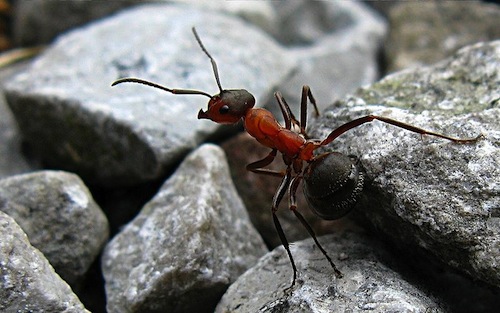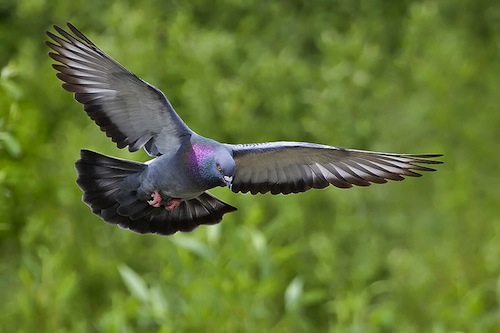 Intelligent Design
Intelligent Design
For Everything a Reason: Why Ants Walk Crooked and Pigeons Circle Around
Some ants walk a zigzag path. Homing pigeons often fly in circles before heading home. Why?
Ant Strategy

It seems costly to take extra steps back and forth. Why do ants do it? What makes an ant walk left, cock its head, walk right, cock its head again, over and over? Scientists at the University of Sussex in England decided to find out. Ants do it, they found, to follow a scent without losing visual control of a target. Writing in Current Biology, they said:
Animals sometimes take sinuous paths to a goal. Insects, tracking an odor trail on the ground or moving up an odor plume in the air, generally follow zigzag paths. Some insects take a zigzag approach to visual targets, perhaps to obtain parallax information. How does an animal keep its overall path in the direction of the goal without disrupting a zigzag pattern? We describe here the wood ant’s strategy when guided by a familiar visual scene. If their travel direction is correct, ants face the goal briefly after each turning point along their zigzag path. If the direction is wrong, they turn rapidly at this point to place the scene correctly on their retina. Such saccade-like turns are rare elsewhere in the zigzag. Similarly, when the scene is made to jump to a new position on their retina, ants wait until an expected goal-facing phase of the zigzag before turning to correct the imposed error. Correctly timed, intermittent control allows an animal to adjust its path without compromising additional roles for the zigzag pattern in gathering visual information or in using odor cues for guidance. [Emphasis added.]
If you’re a hunter, you know the strategy. Even if you are walking in the right basic direction, you train your dog to zig and zag to follow the scent. The resultant vector becomes more accurate with the waxing and waning of olfactory cues: if the odor weakens on the left, the dog adjusts the path more to the right. In addition, the dog becomes more aware of its surroundings.
So it’s a strategy. With a zigzagging path, a wood ant can not only stay on course but quickly re-orient if artificially moved to a new location. The authors conclude:
These findings demonstrate a strategy of phase-dependent control that guides the zigzag approach of wood ants to a visually defined goal, while at the same time giving ants the opportunity to scan the surrounding scene.
Pigeon Strategy

Pigeons have a suite of remarkably accurate senses, including the ability to sense the Earth’s magnetic field, follow astronomical cues, and evaluate directions by their superb sense of smell. It’s unlikely many of us could walk home using only our noses, but apparently pigeons can follow a complex mix of odors in the air to zero in on their target. As they fly in circles for the first few minutes, they "read" the magnetic field and sample the cocktail of odors in the air, looking for that familiar smell of home.
A paper in Biogeosciences explains how "trace gases together with winds imply exploitable information for bird navigation." H. G. Walraff of the Max Planck Institute for Ornithology in Germany describes how the air and wind provide birds with a wealth of information to compare with the familiar smell of home:
To orient their courses homeward from distant unfamiliar areas, homing pigeons require long-term exposure to undisturbed winds at the home site and olfactory access to the environmental air at home and abroad…. Referring to particular similarities and dissimilarities depending on home-wind direction, they try to estimate, at each site, the compass direction they should fly in order to approach home.
Walraff sampled the air at 96 sites, finding 46 "omnipresent compounds" whose concentrations vary by location. He used "virtual pigeons" in a mathematical model to show how real pigeons could use trial and error to calculate the direction home based on smell alone.
To make the model work, an iterative algorithm imitates evolution by modifying sensitivity to the individual compounds stepwise at random. In the course of thousands of trial-and-error steps it gradually improves homeward orientation by selecting smaller sets of most useful and optimally weighted substances from whose proportional configurations at home and abroad it finally derives navigational performances similar to those accomplished by real pigeons. It is concluded that the dynamic chemical atmosphere most likely contains sufficient spatial information for home-finding over hundreds of kilometres of unfamiliar terrain.
We’ve often noted that any algorithm that "imitates evolution" is really employing intelligent design, because (unlike Darwinian evolution) it has a goal. Pigeons have a goal, too; so the sampling "algorithm" they use with randomly sampled data keeps them focused on that goal. Walraff, who has studied real pigeons for many years and wants to apply his model to the real world, said "The underlying chemo-atmospheric processes [real birds use] remain to be clarified."
The paper was summarized on PhysOrg under the headline, "How homing pigeons may smell their way home." The article gives some background that led Walraff to his model:
Experiments over the past 40 years have shown that homing pigeons get disoriented when their sense of smell is impaired or when they don’t have access to natural winds at their home site. But many researchers were not convinced that wind-borne odours could provide the map pigeons need to navigate. Now, Hans Wallraff of the Max Planck Institute for Ornithology in Seewiesen, Germany, has shown that the atmosphere does contain the necessary information to help pigeons find their way home.
To use that olfactory information, a pigeon not only needs a good sense of smell, but the ability to run some sophisticated algorithms. It must keep track of varying ratios among dozens of individual odors, while simultaneously noting the wind speed and direction.
At home, a bird is thought to associate certain smells with particular wind directions. "If the percentage of compound A increases with southerly winds, a pigeon living in a loft in W�rzburg learns this wind-correlated increase. If released at a site some 100 km south of home, the bird smells that the ratio of compound A is above what it is on average at its loft and flies north," Wallraff explains. To use an analogy, a person in Munich could smell an Alpine breeze when there is wind blowing from the south. When displaced closer to the mountains, they would detect a strong Alpine scent and remember that, at home, that smell is associated with southerly winds: the person would know that, roughly, they needed to travel north to find home.
From the complex varying odor information, the bird builds a mental "map" of its surroundings so that it can find the proper orientation to get home.
Conclusions
"Strategies" and "algorithms" are words in the vocabulary of intelligent design. This is not to say that ants and birds are intelligent designers. Just as we can see robots employing strategies and algorithms due to the design impressed upon them by human designers, we can infer that intelligent design was the source of the strategies employed by these animals.
The PhysOrg article repeated the misleading statement that evolution is involved:
The model uses an iterative approach to imitate animal evolution by introducing random mutations in the virtual pigeons, making them most sensitive to those volatile compounds that are most effective for navigation. By selecting the best mutations in the course of thousands of generations, the model creates virtual pigeons capable of finding their bearings as well as real pigeons, showing that even inexperienced birds could use atmospheric information for navigation. The findings present a missing piece in the puzzle of homing pigeon navigation, confirming that winds and odours can indeed work as a map system.
Once again, though, the context is intelligent design, not Darwinian evolution. Words like model, best, effective, bearing, navigation, information, and map system assume a mind to be active, evaluating, designing and strategizing. When we see ants and pigeons behaving in concert with these concepts, the conclusion follows from our uniform experience that intelligent design was the vera causa of the behaviors.
Images: Wikipedia.
